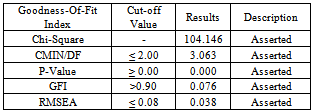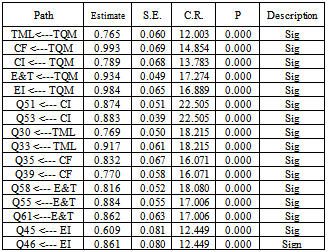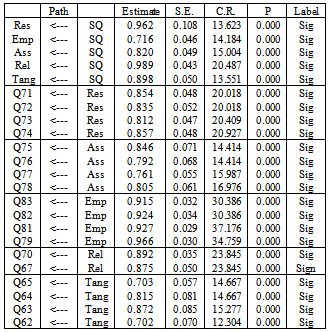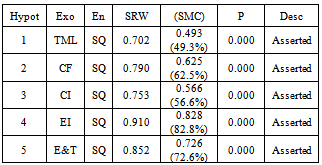-
Paper Information
- Next Paper
- Paper Submission
-
Journal Information
- About This Journal
- Editorial Board
- Current Issue
- Archive
- Author Guidelines
- Contact Us
Management
p-ISSN: 2162-9374 e-ISSN: 2162-8416
2013; 3(4): 230-236
doi:10.5923/j.mm.20130304.06
The Relationship between TQM and Service Quality in the Libyan Judiciary System
Esmael Abdulah, Syed. Omar
Graduate School of Business, University Tun Abdul Razak, Kuala Lumpur, 50100
Correspondence to: Esmael Abdulah, Graduate School of Business, University Tun Abdul Razak, Kuala Lumpur, 50100.
| Email: |  |
Copyright © 2012 Scientific & Academic Publishing. All Rights Reserved.
Total Quality Management (TQM) that focuses on better quality services and products, continues improvement, and improvement in performance standards is one of the concepts that has been adopted in organizations worldwide. Nevertheless, there has been lack of studies that look at the relationship between TQM, and service quality in the Libyan context. Hence, this study examines the relationship between Total Quality Management (TQM) and Service Quality )SQ).A quantitative approach was used in this study to gather the data Moreover, the primary data of some existing variables were assumed to be affecting the service quality in the judiciary as follows: “top management leadership, customer focus, continuous improvement, employee involvement, and education and training. The data was collected from 360 respondents using a structured questionnaire. The questionnaire consisted of three sections. The target questions focused on TQM and SQ. The demographic variables asked are gender, age, education, job position, length of service and name of respondent institution. The data were analyses using the SPSS version 20 software program and analyzed using AMOS version 20. Several statistical validity tests and analysis were conducted, such as reliability and composite reliability tests, validity tests using confirmatory factor analysis (CFA) for construct validity, discriminant validity for multicollinearity treatment, descriptive analysis, correlation and structural equation modeling analysis using AMOS 20.0.
Keywords: Total Quality Management, Service Quality
Cite this paper: Esmael Abdulah, Syed. Omar, The Relationship between TQM and Service Quality in the Libyan Judiciary System, Management, Vol. 3 No. 4, 2013, pp. 230-236. doi: 10.5923/j.mm.20130304.06.
Article Outline
1. Introduction
- Over the past two decades, Total Quality Management (TQM) has become the most widely used management acronym and is considered the buzz word in management practices. It has been well accepted by managers and quality practitioners as a change management quality approach (Arumugam et al., 2009). It plays a vital role in the development of management practices (Prajogo and Sohal, 2003; Hoang et al., 2006). Various technical concepts have evolved to improve product or service quality, and one of these is TQM. In view of Japan’s success in employing quality approaches an increasing number of organizations worldwide – be they large or small – have begun to invest in TQM. Both government and private organizations face the challenge of developing better quality services and products, improved performance standards, and greater responsiveness to be competitive in the global marketplace (Soltan, 2006). To achieve their respective competitive goals, companies and organizations are compelled to invest a significant amount of time and money to study and improvise the quality of their internal and external services. The key to success comes from positive examples that have recognized the importance of innovation and quality. Thus, TQM has become the driving force behind many changes occurring in today’s organizations. However, as Sohal and Terziovski (2000) cautioned, there is no single effective way to implement the TQM philosophy. TQM is an approach that is unique to the needs and culture of an organization; it must be developed independently (Irani, Beskese, and Love 2004). The quality of services plays an increasingly important role in the development of many countries. Today in the global competitive environment the challenge is to provide high quality services as a key strategy for success and survival ( Prabha Munhurrun et al. 2010). Even public sector organizations have come under increasing pressure to deliver quality services and improved efficiencies (Robinson, 2003). Customer needs and expectations are changing when it comes to governmental services and their quality requirements. However, service quality practices in public sector organizations are slow and this is further exacerbated by difficulties in measuring outcomes.
1.2. Research Objectives
- Based on the introduction and the research problem defined above, the main objective of this study was to examine the influence of TQM on service quality in the Libyan judiciary system. The specific research objectives are as follows:1. To examine the relationship between top management leadership traits and service quality in the Libyan judiciary system.2. To examine the relationship between costumer focus and service quality in the Libyan judiciary system.3. To examine the relationship between employee involvement and service quality in the Libyan judiciary system.4. To examine the relationship between continues improvement practices and service quality in the Libyan judiciary system.5. To examine the relationship between education and training and service quality in the Libyan judiciary system.
2. Literature Review
2.1. Total Quality Management
- The years, TQM dimensions have been defined in a variety of ways by a number of scholars and researchers (Prajogo and Sohal, 2003). However, owing to the vast array of TQM definitions and different methods used by scholars to assess its implementation, inconsistencies in their studies makes reaching a conclusion on the practices and dimensions of TQM difficult (Wen.Yi Sit et al., 2011). Although the philosophies of quality gurus, such as Deming, Juran, Crosby, and Ishikawa, provide fundamental propositions on which total quality is based, these propositions are seldom accompanied by rigorous supporting evidence, even though they may have some degree of face validity. Reed (2000) systematically reviewed the TQM philosophies proposed by the quality gurus and observed the five elements of TQM, namely, customer focus, leadership and top management commitment, training and development, teamwork, and culture, on which all of them had reached teamwork, and culture, on which all of them had reached an agreement.Badri et al. (1995) identified, tested, and validated eight constructs of TQM through an empirical survey of 424 manufacturing and service firms in the United Arab Emirates, an oil-rich developing country in the Middle East. They discovered that the critical factors of TQM implementation are top management awareness about quality improvements, coordination between the quality department and other departments, training, quality data and reporting, employee involvement, process management, product/service design, and supplier quality management. In addition, Sila and Ebrahimpour (2003) investigated TQM survey-based research published between 1990 and 2000, and observed that the most frequently investigated factors were customer focus, leadership and top management commitment, teamwork, and employee involvement.According to Najeh and Kara-Zaitri (2004), many researchers have also investigated the critical success factors of implementing TQM and they have produced relatively the same factors as the previous studies. Organizations are generally prepared to implement only the aspects of TQM programs that can provide them with competitive advantage and improve their overall performance. Organizations must use a systemic approach to manage their interrelated processes (Sherif, 2010). The literature identifies important TQM elements that contribute to the successful implementation of TQM and that should be adopted by service organizations in implementing TQM in Libya.Several methods have been used to identify TQM dimensions. Black (1993), Ahire et al. (1996), and Zhang (2000) used factor analysis to do this. In the current research, the approaches based on judgmental processes were employed because of the quantitative method used in the analysis.Cheung (2006), Besterfield et al. (2005), Karajewisky and Ritzam (1996)and Bank (2000) agreed that the basic principles of TQM include customer satisfaction, top management commitment, continuous improvement, participation of employees, and involvement and empowerment of employees. These variables were included in the study. TQM also consists of many parts that stem from professionals’ concepts, empirical surveys, case studies, concepts supported by experts, and quality awards. Najeh and Kara-Zaitri (2004), Sayeh et al. (2005), and Soltan (2006) supported Cheung’s opinion by pointing out that these factors could be established by seeking expert opinions within an organization. For this study, five dimensions of TQM namely, top management leadership, customer focus, employee involvement, continuous improvement, education and training, have been identified as the critical factors for the implementation of TQM in the Libyan judiciary. These five dimensions cover almost all the TQM factors discussed in the literature review are found to be useful and relevant to the service organizations, and were aligned with the concepts proposed by the five researchers mentioned earlier.However, this study focused on how TQM influences the quality of service provided by the Libyan Judiciary System to the customer based on the perception of employees.
2.2. Service Quality
- Several studies all over the world have confirmed that service quality is positively correlated with perceived value (Cook and Verma, 2002). Given its influence on service guarantees service quality has become a major management concern in reforming business management approaches. Furthermore, studies argue that the absence of a clear definition of service quality, considered by researchers as an indefinable and intangible concept, makes assessing the service quality of an organization difficult (Lee et al., 2000). To make the process easier, organizations are compelled to obtain an adequate understanding of the factors effecting service quality and to identify the best methods to measure such factors (Parasuraman et al., 1985, 1988).Among the various concepts of service quality, two of the most widely accepted and used by researchers is the SERVQUAL model by Parasuraman et al. (1988) and the technical/functional quality framework by Gronroos (1998). Parasuraman et al. (1988) proposed a conceptual framework of service quality based on the interpretation of qualitative data from extensive explanatory research performed in four service businesses. The SERVQUAL instrument by Parasuraman et al. (1988) included two 22- item sections. The intent is to measure customer expectations of various aspects of service quality and customer perceptions of the service they actually received from the local service organization. Parasuraman et al. (1988) in their research found that customers consider five dimensions in their assessment of service: reliability, responsiveness, assurance, empathy, and tangibles, which represent how the customers organize information on service quality (Cook and Verma, 2002).
2.3. Research Framework
- This paper focused its investigation on the relationship between TQM and SQ in the Libyan judiciary system. In this study, TQM represented the dependent variable, while service quality, represented the independent variable.
 | Figure 1. Theoretical Model of Study |
3. Methodology
- The unit of analysis in this research is the Libyan judiciary system focusing on three main departments, namely, the Center for Judicial Expertise and Research, Administration and Financial Affairs Department and the Registration and Documentation Department. This study focused on how TQM influences the quality of service provided by the Libyan judiciary system to the customer based on the perception of employees.A total 360 internal customer responses were considered sufficient to make a generalization and complete the data analysis. The customers were randomly selected using the judgment sampling technique as the sampling method; each participating departments was allocated with 83 questionnaires.This research was conducted through a self-administered questionnaire and the questionnaire consisted of three sections. The scaling used in this research is the 5-point Likert scale of 1-strongly disagree, 2-disagree, 3-neutral, 4-agree and 5-strongly agree. The demographic variables asked for were gender, age, and education job position, length of service and name of respondents institution. The data was analysed using the SPSS version 20 software program and analyzed using AMOS version 20. Several statistical validity tests and analysis were conducted such as reliability test and composite reliability tests, validity tests using confirmatory factor analysis (CFA) for construct validity, discriminant validity for multicollinearity treatment, descriptive analysis, correlation and structural equation modeling analysis using AMOS 20.0.
4. Findings
- Among the respondents, 80% of 360 respondents are male while 20% female. The age category is presented at 4 main levels, where 31.8% of respondents were aged between 20 and 30 years, 37.5% between 31 and 40 years, 25.5% between 41 and 50 years and 5.7% more than 50 years old. . It was observed that the 3.1% of 360 respondents held primary degrees, 26 % Secondary degrees and 57.2 % of them Graduate degrees and 13.1 % Postgraduate degrees. In term of marital status 34.4 % of 360 respondents were work in Center for Judicial Expertise and Research, 33.3% work in The Registration and Documentation, 32.2% in Administration and Finance Affairs. We also observed that the 6.1% of 360 respondents had less than two years’ engagement with the judiciary system, 24.7 % had between 2 and 4 years, 44.2 % had between 5 and 7 years and 25.0 % of them had between 8 and 10 years. This indicates that the respondents have a medium level of experience and this may be because the subject is relatively new in Libya.
4.1. Re-Specified Model of Total Quality Management
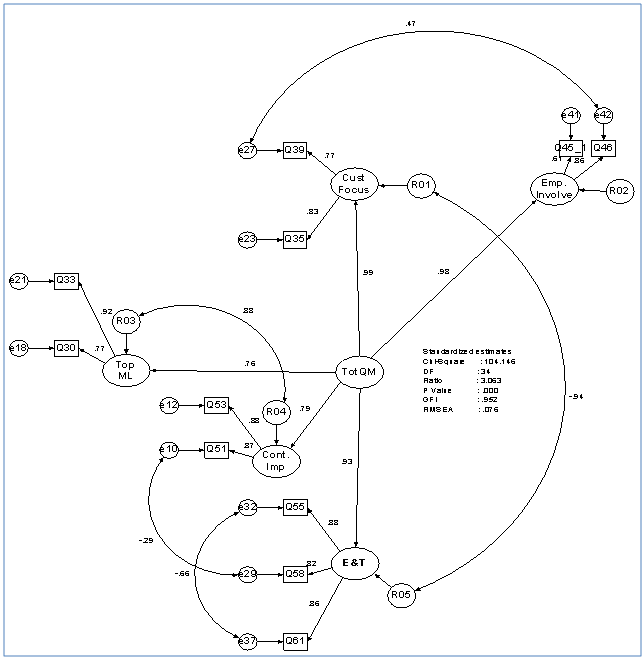 | Figure 2. Re-Specified Model of Total Quality Management |
|
|
4.2. Re-Specified Model for Service Quality
- The service quality constructs, as a measurement model, is within the acceptable level, indicating a sound fit of the data to the model as shown in Figure 3 below. The chi-square goodness of fit is significant due to the large sample size, i.e. more than 150, and provides an acceptable fit. As evidence of convergent validity, all items loaded on their pre-specified constructs. The goodness of the model fit (χ2 = 274.068, DF= 125, Ratio = 2.193, P = 0.000, GFI = 0.925, RMSEA = 0.058) confirmed the significant model of service quality model. Through confirmatory factor analysis (CFA), and 2nd order analysis, the present study confirmed the five dimensions of service quality with 18 items as valid measures.Based on the CFA and the 2nd Order CFA result, it was observed that the factor loadings of all observed variables or items are adequate. This indicates that most of the constructs conform to the convergent validity test (Hair et al., 2010). The goodness of fit indices for the five latent constructs of service quality (Tangibles=0.898, Reliability=0.989,Responsiveness=0.962, Assurance=0.820, and Empathy=0.716) confirmed the dimensions of service quality as the exogenous variable in the context of the public sector in Libya.
|
 | Figure 3. Re-Specified Model of Service Quality |
|
4.3. Findings of Hypotheses
- Table 5 demonstrates that hypothesis H1 to hypothesis 5 are asserted. Furthermore, the re-specified model generates five paths to be directly influencing service quality. Table 5 indicates that the five exogenous variables (Top Management Leadership, Customer Focus, Continuous Improvement, Employee Involvement and Education and Training) significantly explained a variance in Service Quality from 49.3% to 82.8%. According to Cohen and Cohen (1988), 40% to 50% indicated as moderate effect and more than 50% as a high effect of exogenous on the endogenous variable.
|
5. Conclusions
- This paper explored the relationship between TQM, and SQ. Results have shown that the dimensions of TQM had a significant effect on service quality. TQM is not an easy practice to be implemented. It demands full commitment from various parties in the organization and requires some changes and restructuring that involves a large amount of time. However, TQM was, on average, implemented for only 7 years. This length may be one of the reasons why the implementation of TQM did not deliver much positive results in this study. TQM stresses the mutual assistance of everyone in an organization and associated business processes to produce services that meet the needs and expectations of customers. Also, quality is generally corporate-driven. Sometimes quality is sacrificed in meeting the bottom line output or immediate customer requirements. In some circumstances, organizations will never sacrifice quality.
 Abstract
Abstract Reference
Reference Full-Text PDF
Full-Text PDF Full-text HTML
Full-text HTML